Start Your Free Trial!
Sign up to our newsletter, stay updated on news and exclusive offers from EaseUS. Don't worry, if you change your mind, you can unsubscribe at any time, free of charge. We value your privacy (Privacy Policy).
Page Table of Contents
Make File Transfer Faster Windows 11/10 with Free File Transfer Software
Fixes for Windows 11/10 Slow Network File Transfer
Solutions to Slow USB Transfer in Windows 11/10
Methods for Windows 11/10 Slow File Transfer on Hard Drives/Disks
Methods Summary
FAQ about Speed Up Network File Transfer Windows 10
Reviews and Awards
| ⚙️Complex Level | Low, Beginners |
| ⏱️Duration | 5-10 minutes |
| 💻Applies to | Speed up file transfer on Windows 11/10 (Network/USB file transfer) |
| ✏️Fixes | |
| 🔨Tools | EaseUS Todo PCTrans |
We are here to help you get rid of the Windows 11/10 slow file transfer problems. In this post, we cut through the useful method for you to make file transfer faster in Windows 11/10. You can speed up network file transfer by using the smart data transfer software - EaseUS Todo PCTrans Free in fix 1.
The following solutions help you to figure out what exactly causes the slow file transfer issue or change the way of Windows 11/10 file transfer on your PC or laptop.
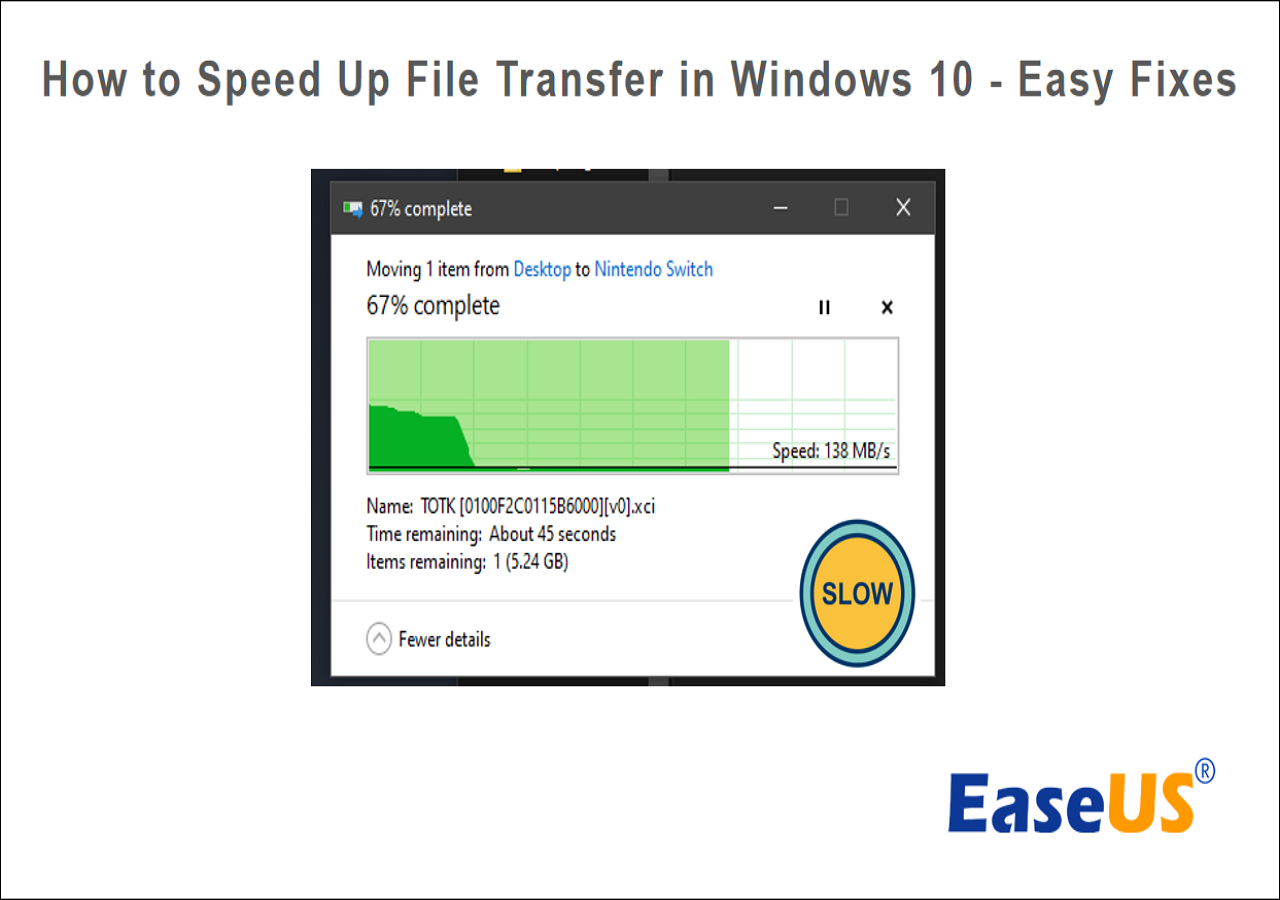
When the file transfer speed slows down on a computer, various reasons may cause it, including network speed, storage capacity of the target drive, file size, etc. A direct way to make the file transfer speed faster in Windows computers is to turn to reliable and fast file transfer software for help.
EaseUS Todo PCTrans Free is a powerful and easy-to-use PC transfer software that can ease you from the slow file transfer issue on your computer. It enables you to migrate files and drive content efficiently via several transfer plans, including:
Here are the detailed steps for Windows file transfer over the network:
Step 1. Set Up the Old PC
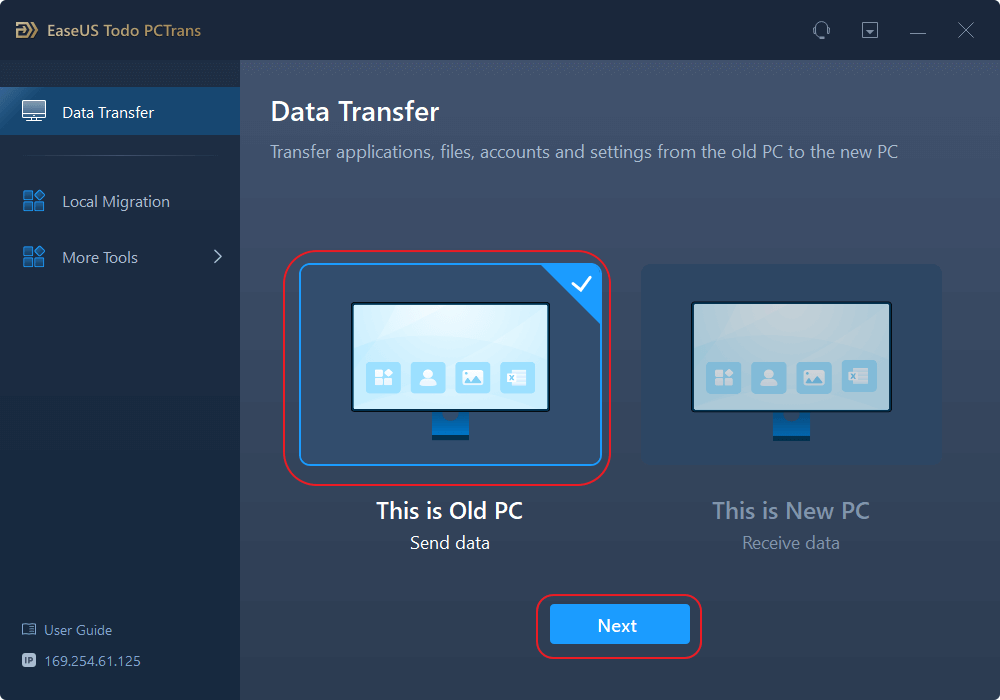
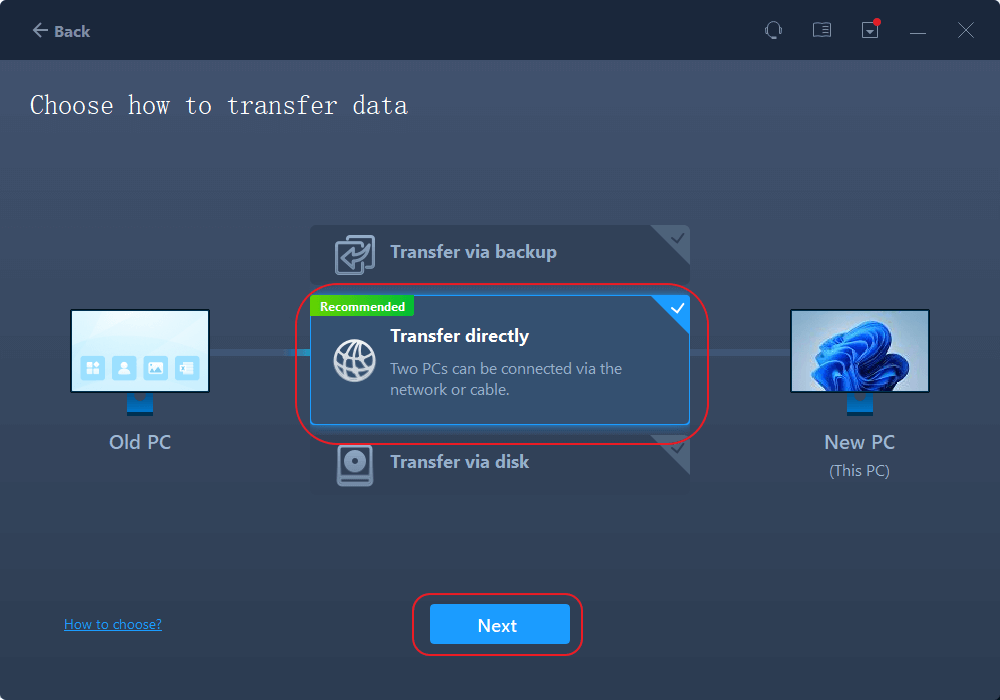
Step 2. Set Up the New PC
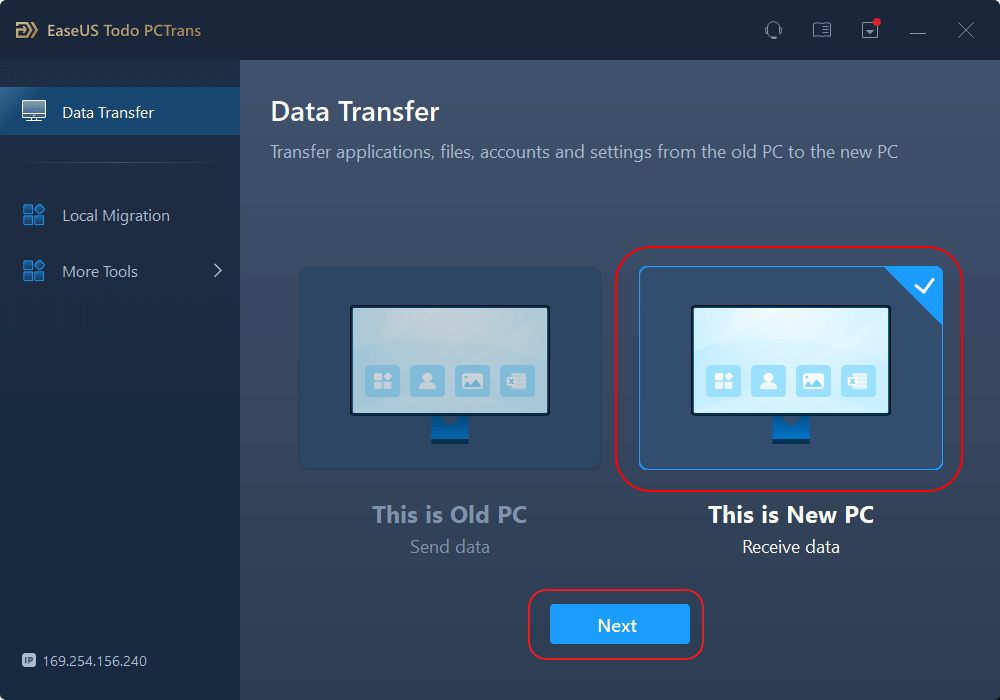
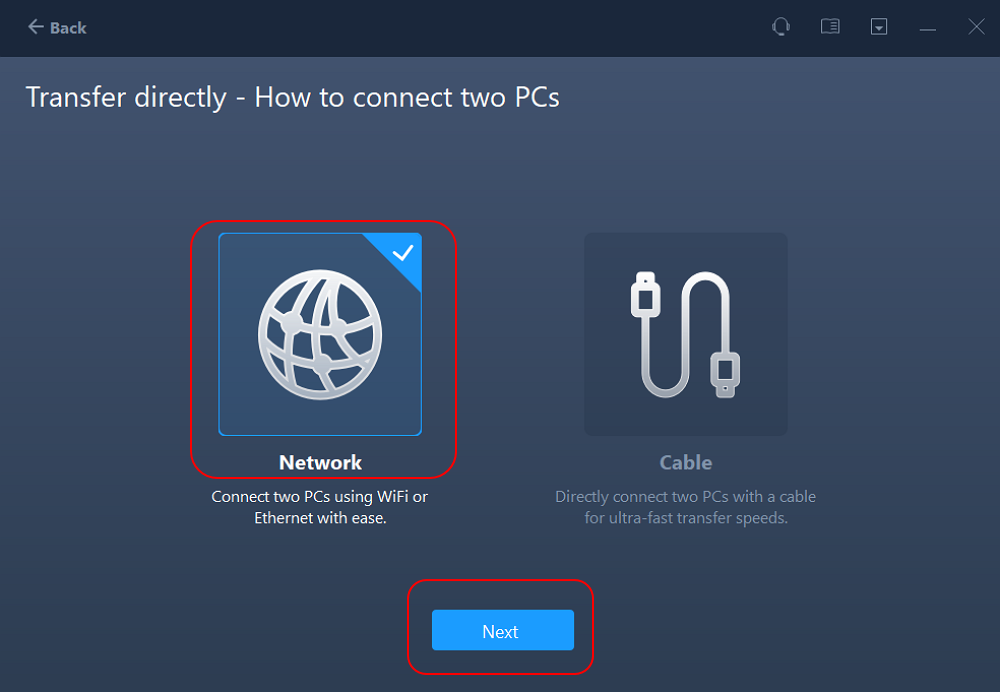

Step 3. Select the Files to Transfer

Also, don't forget to share this tutorial online to help more people fix Windows 10 slow file transfer error:
Furthermore, we put three solutions here to cope with the very slow file transfer in Windows 11/10, which contains network problems, external drive problems, or computer problems. You can choose the best method for increasing file transfer speed in Windows 11/10. Take it easy and check your methods one by one.
Some people may find that the network data transfer becomes very slow in Windows 11/10. To solve the problem, the two approaches below are worth trying.
If you are copying some data over the network, the auto-tuning feature can improve the performance of programs that receive TCP data over a network. But in some situations, disabling this feature might bring a faster copy speed.
Step 1. Press the Windows key + X and select Command Prompt(Admin).
Step 2. Type netsh int tcp set global autotuninglevel=disabled and press Enter.
Step 3. Now, try to transfer the files and check the data transfer speed. You can go to Command Prompt(Admin) again and type netsh int tcp set global autotuninglevel=normal and press Enter to turn on the Auto-tuning again.

The Remote Differential Compression feature can cause slow network file transfer in Windows 10. To fix this problem, you need to disable this feature on your PCs by doing the following.
Step 1. Press Windows Key + S and enter windows features. Click "Turn Windows features on or off."

Step 2. Find and uncheck Remote Differential Compression and click "OK."

Step 3. Restart your PC. You need to repeat this on all the computers on your network. After that, check if the problem is still there.
After the process, you will find your network data transfers faster. Click the buttons below to share these fixes with others.
Copying files between USB drives and computers is one of the most basic ways to share data. But lots of users complain that their PCs are transferring files very slowly on Windows 11/10. The easiest way you can try is to use a different USB port/cable or check/update the USB drivers if they are outdated. If the situation doesn't improve, continue to use the following advanced solutions.
The first step to fix the slow USB transfer issue is checking its state. You can use the Windows built-in tool for help. Once you start the process, it will find the corrupted sectors and fix them if needed.
Step 1. Open "This PC" or "File Explorer".
Step 2. Right-click on the USB drive or hard drive and click "Properties."
Step 3. Click the "Tool" tab. Under the "Error-checking" section, click "Check."

The external USB drive or HDD on your computer provides you with a Quick removal policy that avoids caching and a better performance policy that writes caching. If your USB flash drive is small-sizes, you'd better choose the former one. If you are using an external hard drive to move large files, the Better performance policy is more appropriate. Let's see how to change the Removal policy.
Step 1. Plugin in your USB or external hard drive to the PC.
Step 2. Click "Start," type Device Manager, and open it.
Step 3. Expand the "Disk drives." Then, right-click on the target drive. Open "Properties" and select "Policy."
Step 4. Choose a Quick removal policy for the USB flash drive and a Better performance policy for the external hard drive.

Share these ways to help others transfer files faster and remove the slow transfer issues.
After you convert the USB drive from FAT 32 to NTFS, there may be visible improvements in the transfer speed. If you don't know how to format a USB flash drive to NTFS, follow this link to see details: Format USB flash drive to NTFS in Windows 10/8/7.
The slow data transfer also can be hardware or computer issues. You might be able to fix this simply by disabling certain antivirus or cleaning up temporary cache files. If these don't work, move to increase the disk transfer speed from the following points.
Windows offers a Drive Indexing feature to index all files and substantially reduce the waiting time when you search for them in File Explorer. However, it can slow the data transfer speed if it starts indexing data while the copying is still going on. So, we suggest that you temporarily disable Drive Indexing for a trial.
Step 1. Open "This PC" or "File Explorer".
Step 2. Select the partition you want to turn off the indexing feature. Right-click it and click "Properties".
Step 3. Uncheck the "Allow files on this drive to have contents indexed in addition to file properties" box and restart your PC to enable the function.

EaseUS Partition Master Free allows users to convert FAT to NTFS without losing data effortlessly. Now, download this free partition manager software, and let's begin.
Step 1. Install and launch EaseUS Partition Master on your computer.
Step 2. Go to the Disk Converter tab, select "FAT => NTFS" and click "Next."
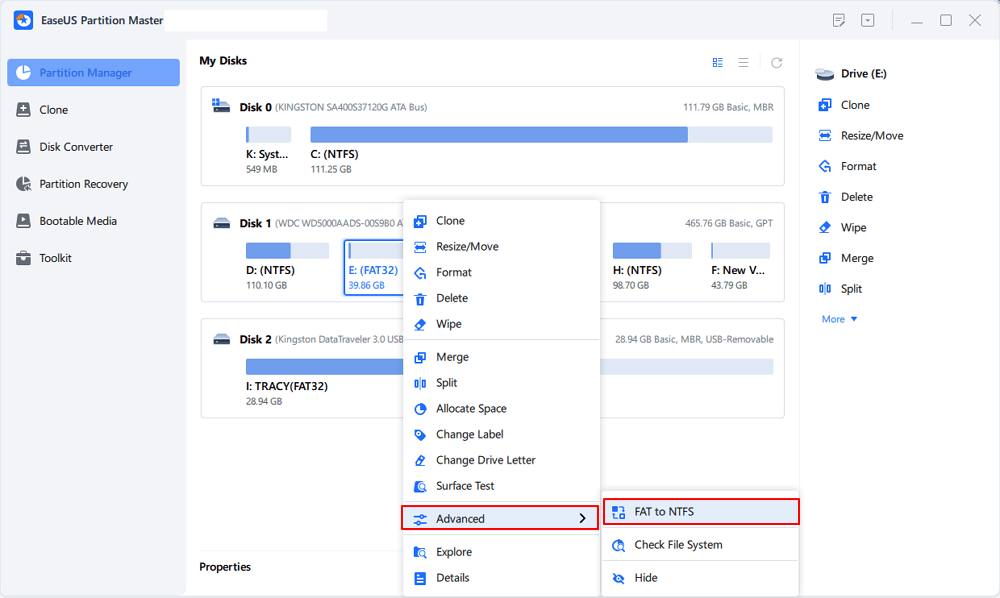
Step 3. Select the partition that you want to convert to NTFS and then click on "Convert." (Tick the "Show More" option in the panel's upper right corner to display the hidden partitions.)
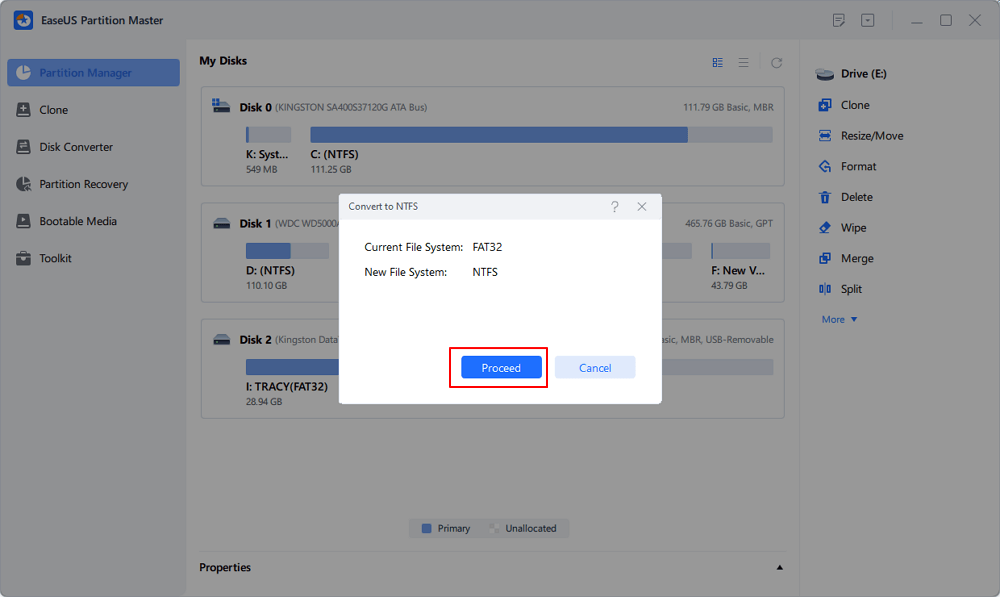
Step 4. Wait until the operation process is finished.
A corrupted Windows 10 file system could disable, interrupt, or slow down the file transfer speed, so let's use the System Maintenance Troubleshooter to repair the wrong files.
Step 1. Open the Control Panel and click on the Troubleshooting icon.
Step 2. Select View all in the top left corner.
Step 3. Run System Maintenance Troubleshooter.
Whether it is a network transfer, USB data copying, or a hard disk data migration, slow file transfer in Windows may be caused by a variety of reasons. If the network transfer is delayed, you can try to find a solution to the network and computer problems. If the USB moving is not fast, you can find the reason from the USB drive and your computer. I hope the above solution can help you effectively.
Finally, if none of the previous solutions help you deal with the slow file copying issue, it's time to try some third-party tools to speed up the transfer. Here, we'd like to recommend you try EaseUS Todo PCTrans.
Do you know how to speed up network file transfer on Windows 11/10 now? If you still have any doubts, this part lists three questions to help you. Check them below:
The network file transfer runs so low that it stems from your network settings and other hardware failures. Sometimes, checking your router settings is a common solution.
If you can not fix slow file transfer in Windows 10, EaseUS Todo PCTrans can help you to transfer files from one computer to another computer without the Internet.
More details:
To fix Windows 10 slow file transfer, we recommend EaseUS Todo PCTrans to move all your data to another PC at a fast speed.
Step 1. Download EaseUS Todo PCTrans.
Step 2. Choose PC to PC mode, and click Start.
Step 3. Connect two PCs via entering the password or verification mode.
Step 4. Select the files you want to transfer.
Sherly joined EaseUS in 2022 and she has always loved writing articles and enjoys the fun they bring. She receives professional training here, focusing on product performance and other relative knowledge. She has written over 200 articles to help people overcome computing issues.
Jean is recognized as one of the most professional writers in EaseUS. She has kept improving her writing skills over the past 10 years and helped millions of her readers solve their tech problems on PC, Mac, and iOS devices.
It offers the ability to move your entire user account from your old computer, meaning everything is quickly migrated. You still get to keep your Windows installation (and the relevant drivers for your new PC), but you also get all your apps, settings, preferences, images, documents and other important data.
Read MoreEaseUS Todo PCTrans Free is a useful and and reliable software solution created to serve in computer migration operations, be it from one machine to another or from an earlier version of your OS to a newer one.
Read MoreEaseUS Todo PCTrans is by the folks at EaseUS who make incredible tools that let you manage your backups and recover your dead hard disks. While it is not an official tool, EaseUS has a reputation for being very good with their software and code.
It offers the ability to move your entire user account from your old computer, meaning everything is quickly migrated. You still get to keep your Windows installation (and the relevant drivers for your new PC), but you also get all your apps, settings, preferences, images, documents and other important data.
Read MoreEaseUS Todo PCTrans Free is a useful and and reliable software solution created to serve in computer migration operations, be it from one machine to another or from an earlier version of your OS to a newer one.
Read MoreRelated Articles
How to Transfer Photos from One iCloud to Another iCloud
![]() Tracy King/2025/01/23
Tracy King/2025/01/23
Wi-Fi Direct and File Transfer Windows 10/11: How to Send Files From PC to PC/Phone to PC
![]() Tracy King/2025/01/23
Tracy King/2025/01/23
How to Completely Uninstall Outlook
![]() Cici/2025/04/01
Cici/2025/04/01
How to Uninstall Star Citizen and RSI Launcher (Full Guide)
![]() Oliver/2025/01/23
Oliver/2025/01/23
How to Increase File Copying or Transferring Speed in Windows 10/11
Try smart Windows 11 data transfer tool to move all data in 1 click.
EaseUS Todo PCTrans
CHOOSE YOUR REGION
Start Your Free Trial!
Sign up to our newsletter, stay updated on news and exclusive offers from EaseUS. Don't worry, if you change your mind, you can unsubscribe at any time, free of charge. We value your privacy (Privacy Policy).
Start Your Free Trial!
Sign up to our newsletter, stay updated on news and exclusive offers from EaseUS. Don't worry, if you change your mind, you can unsubscribe at any time, free of charge. We value your privacy (Privacy Policy).